When you walk into a home without a proper entryway, things can get messy fast. Shoes pile up, keys vanish, and guests step right into your living room with zero transition. This is a headache in so many apartments and small houses where every inch counts. But hey, just because you don’t have a dedicated foyer doesn’t mean you can’t have a functional welcome area.
Remember to repin your favorite images!
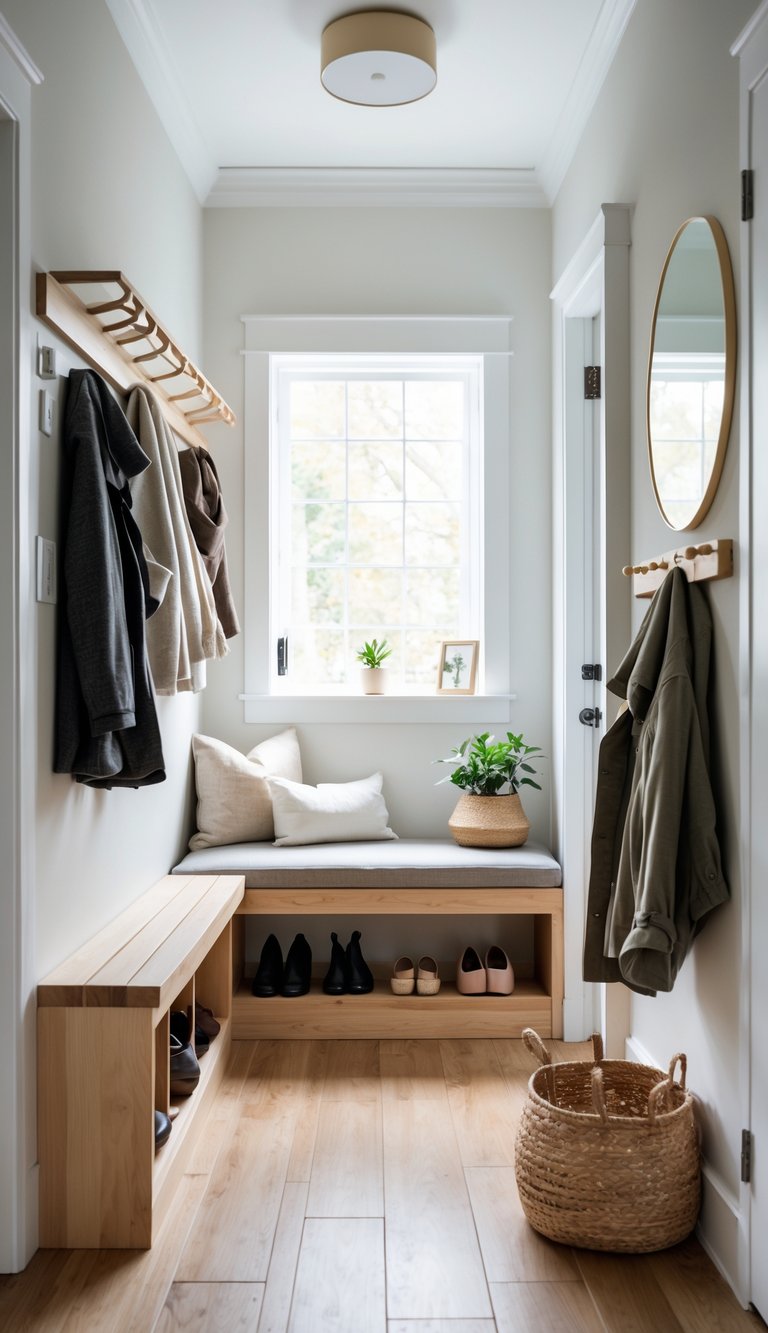
With a bit of creativity and some smart design, you can carve out a practical and stylish entryway even in the tiniest spaces. Try multi-functional furniture like benches that hide storage, wall-mounted shelves to use your vertical space, and clever organizational tricks to keep your essentials handy but not in the way.
Your best entryway setup depends on what you actually need and the space you’ve got. Maybe a slim IKEA wardrobe hack fits your spot, or maybe all you want is a bold mirror and a narrow console table to mark the area. Whatever the situation, you can totally turn your entrance from chaos into a welcoming first impression.
Understanding Your Entryway Space
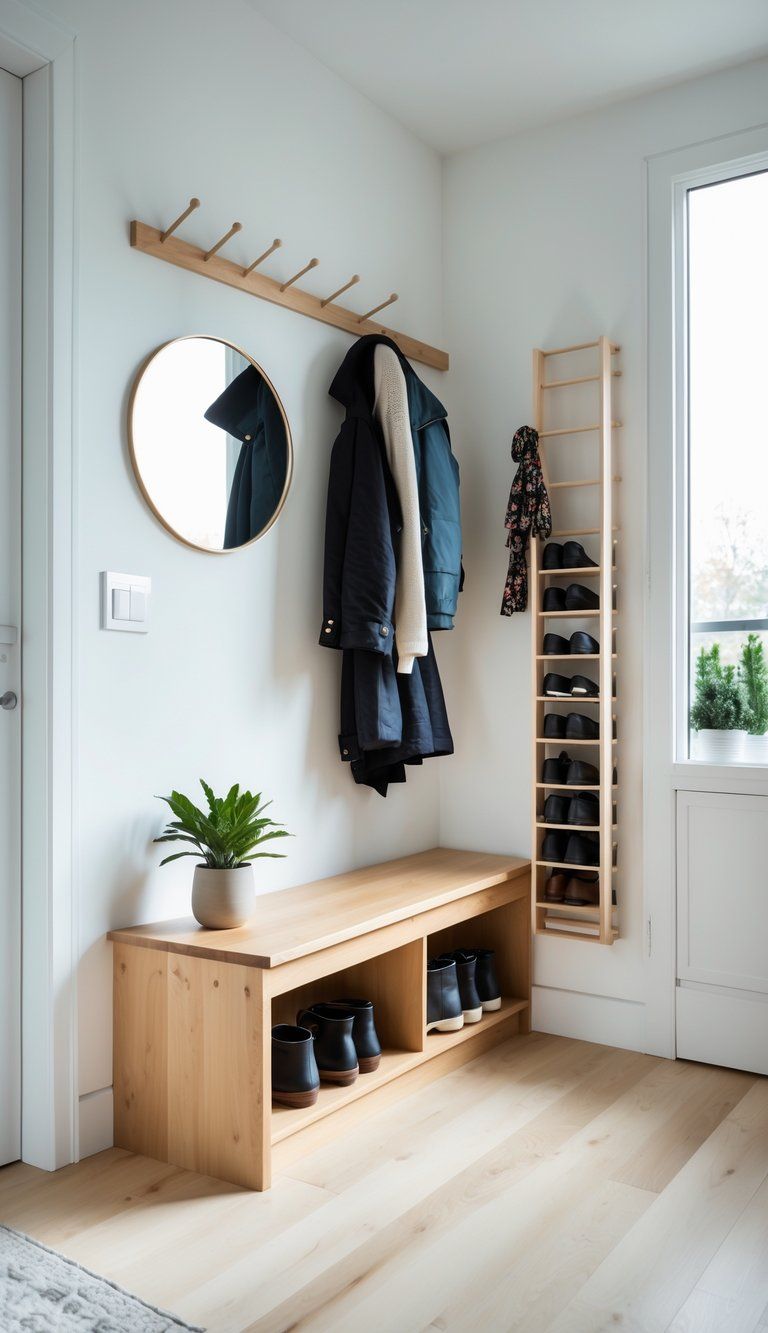
Before you start, get a handle on what you’re working with. The layout, your constraints, and what kind of vibe you want all shape how you’ll design this little but important spot.
Assessing Entryway Layout
Grab a tape measure and jot down your entryway’s width, length, and ceiling height. Notice any doors, windows, or built-ins that you can’t move. Watch how people move through the space—do they walk straight in, turn a corner, or squeeze past something?
Think about where the entryway leads. Is it right into your living room? Maybe it’s a tiny hall or just a corner by the kitchen.
Check out where your outlets and switches are. Good lighting matters here, so knowing your power spots helps when you’re picking fixtures.
Draw a quick floor plan or snap some photos from different angles. Having a visual makes shopping and planning so much easier.
Identifying Space Constraints
Be real about your limits. Small entryways need different solutions than big, fancy foyers. If you’ve got a narrow spot, look for slim furniture that won’t block the way.
Low ceilings? Skip the big hanging lights and stick with flush-mounts.
Think about the seasons too. Will you need space for winter boots and coats? Or maybe just a spot for summer hats and bags? Your storage needs can shift a lot throughout the year.
Just watch the space for a few days—where do you drop your bag, toss your keys, or pile the mail? That’ll tell you what you really need.
Defining the First Impression
Your entryway basically sets the mood for your whole home. What do you want people to feel when they walk in—calm, excited, cozy, or maybe a little fancy?
Pick a style for this space. Should it match the rest of the house, or do you want something bold and different here? Choose colors that fit the vibe and won’t clash with nearby rooms.
Maybe add a statement piece, like a dramatic mirror, cool lighting, or a unique console table. Amber Interiors swears by oversized mirrors to anchor the area and bounce light around.
Think about the senses too. Would a little fragrance diffuser, a green plant, or a soft rug make it feel more inviting?
Planning a Functional Entryway
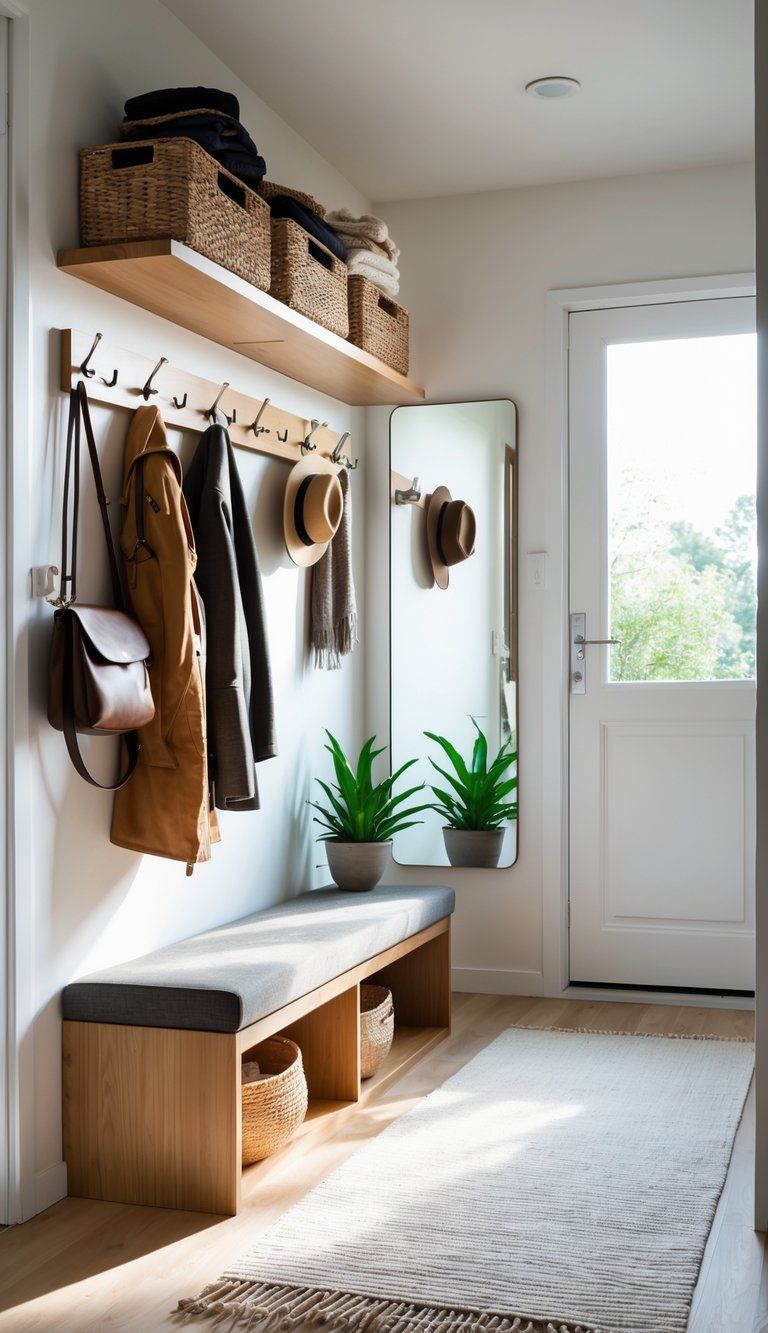
Planning is everything with a small entryway. This spot is your home’s first impression and the place that handles all your comings and goings.
Setting Priorities for Daily Use
Start by thinking about what you actually do here. Do you drop keys, open mail, or kick off your shoes? Jot down your must-haves.
Storage comes first. List out the stuff you use every day:
- Jackets and scarves
- Shoes
- Bags or backpacks
- Keys and wallets
Match your storage to these things. Wall hooks keep stuff in sight and easy to grab. Cabinets or baskets hide the mess.
Don’t forget, your needs change with the seasons. You’ll want more coat storage in winter, but maybe just a spot for totes or sports gear in summer.
Establishing a Focal Point
Every good entryway needs something to anchor the space. Your focal point should look good and serve a purpose.
A console table works great if you’ve got the room. It gives you a place for keys, mail, and a little decor. In small spaces, try a wall shelf or a slim floating console to save floor space while still marking the area.
Here’s a tip: Put your main piece across from the door if you can. That way, people don’t crowd the entrance right away.
Top it off with some art or a mirror. Mirrors make the space feel bigger and give you a last look before heading out.
Zoning and Visual Boundaries
Even if you’ve got an open floor plan, your entryway needs a clear “zone.” Visual cues help separate this spot from the rest of your home.
Throw down a rug to define the area. Pick something tough and washable since it’ll get dirty. Let it reach a couple feet into the space.
Paint can set boundaries too. Try a different color or some wallpaper to make the entry pop.
Arrange your furniture to guide people through, not block them. Leave at least three feet of space to walk.
If you’re really short on space, use the walls. Hang storage up high to draw the eye up and make the most of what you’ve got.
Entryway Storage Solutions for Tight Spaces
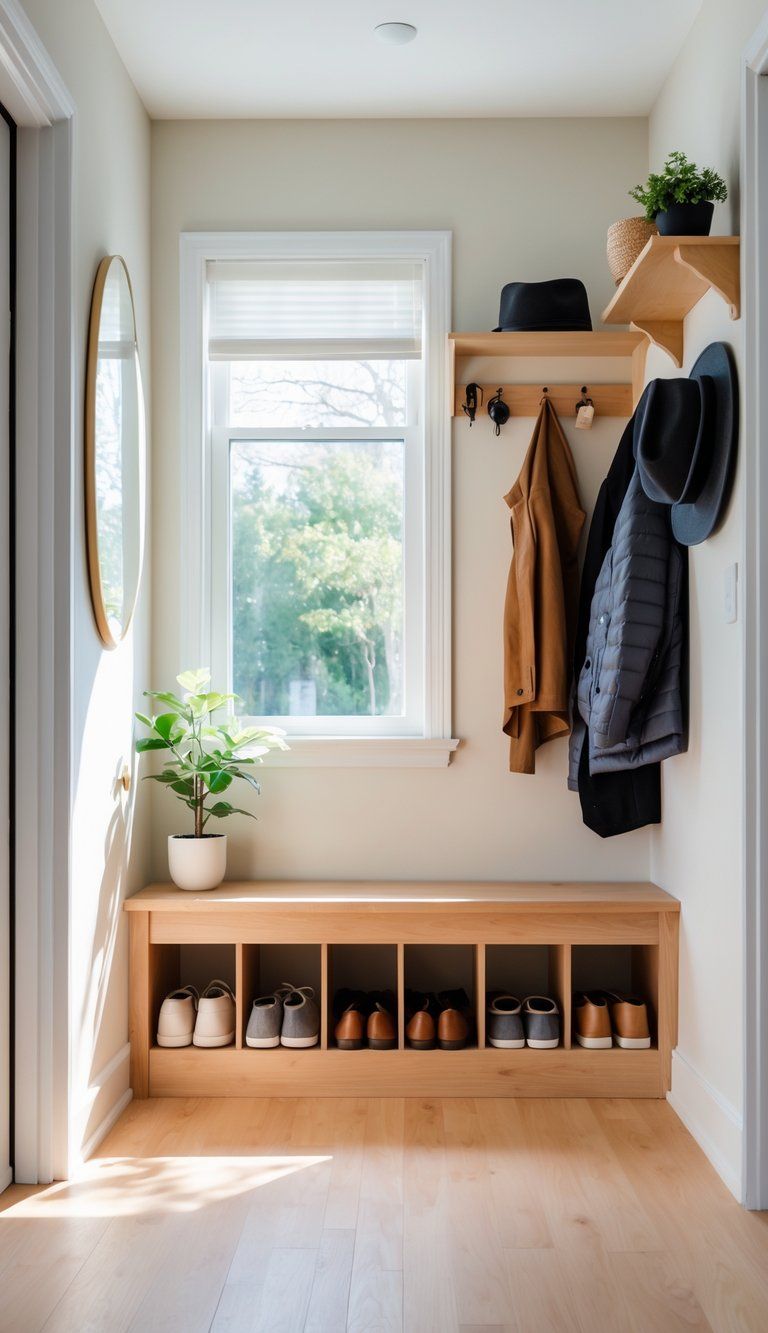
Tiny entryways can still be super functional if you get smart with storage. Organization is key for turning cramped corners into handy drop zones.
Utilizing Vertical Storage
Your walls are gold in a small entryway. Floating shelves add storage without stealing floor space. Stack them at different heights for different stuff—mail and keys up high, shoes down low.
Wall hooks are lifesavers for coats, bags, and hats. Try a row for grown-ups and another lower for kids. Seriously, just adding hooks can clear up clutter fast.
Tall, skinny cabinets use vertical space really well. Some are only a foot deep but can store a ton.
Pro tip: Stick little hooks or pockets inside cabinet doors for keys and tiny things.
Maximizing Hidden Storage
Storage benches do double duty—sit on top, stash stuff underneath. Lift-up seats hide shoes, scarves, you name it.
Custom built-ins can fill awkward corners perfectly. They cost more, but you’ll use every inch.
Furniture with hidden compartments works great in open layouts. Look for console tables with drawers or ottomans that open up.
Easy fix: Slide baskets under a table for instant grab-and-go storage.
Incorporating Smart Storage Ideas
Go for multi-use pieces to keep things organized but not crowded. Wall-mounted mail sorters with key hooks, or mirrors with built-in shelves, pull double duty.
Clear bins keep things tidy but let you see what’s inside. Use labeled boxes for each family member’s shoes or gear.
Rotate stuff by season so you don’t crowd the entryway. Put off-season items somewhere else.
Quick tips:
- Use slim hangers for more coat space
- Add motion lights to dark corners
- Give keys and sunglasses a dedicated spot
Measure your space before you buy anything, just to be safe.
Choosing Functional Entryway Furniture
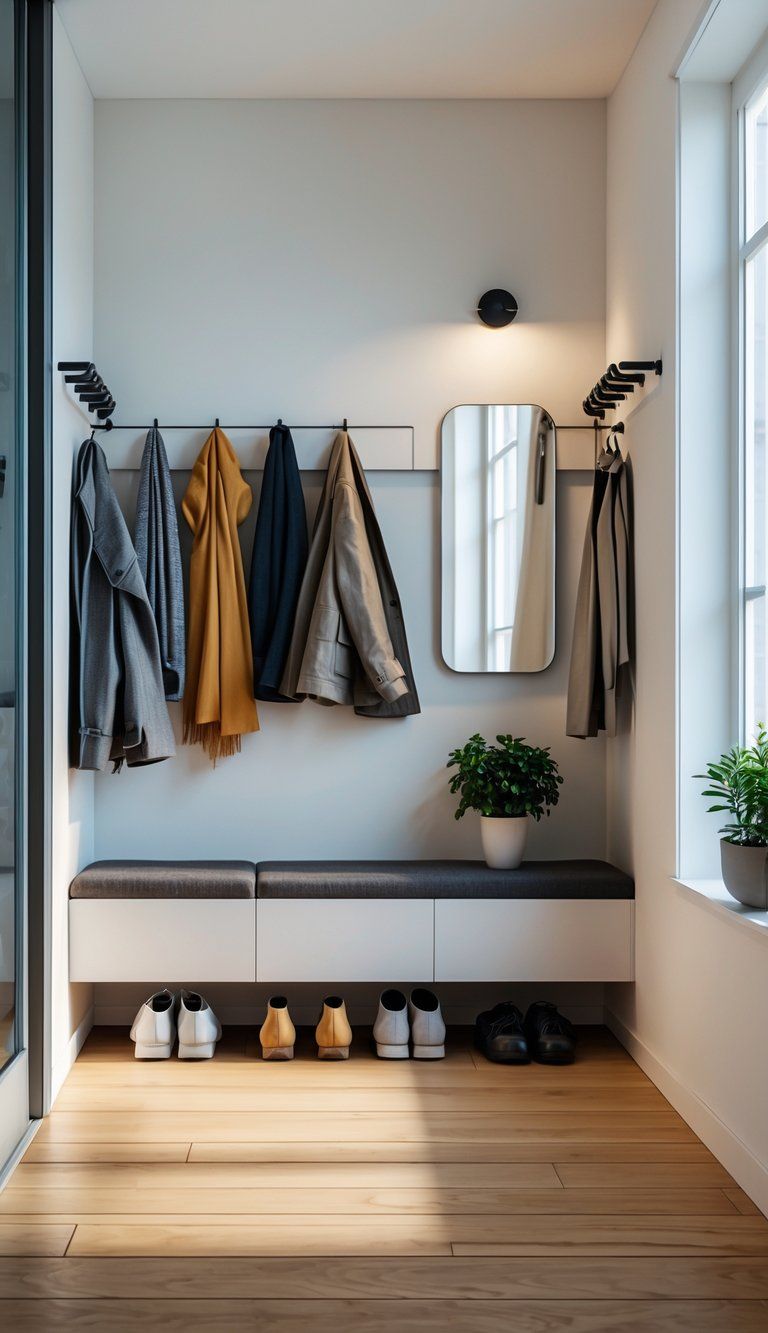
The right furniture makes or breaks your entryway. Go for pieces that multitask to keep things organized and stylish—even in a tiny spot.
Benches and Seating
A bench is honestly one of the best entryway furniture investments. It gives you a place to sit for shoes, which is huge for kids or anyone who doesn’t want to wobble on one foot.
Pick benches with storage underneath for shoes, bags, or out-of-season stuff. Some have cubbies, drawers, or lift-up seats.
If space is tight, try a shoe bench with shelves. These pack a lot of storage into a small footprint.
Wall-mounted folding seats are a clever fix for really small entryways. Flip them down when you need them, fold them up when you don’t.
Slim Console Tables
A narrow console table is perfect for tight entryways. Look for ones under a foot deep to keep the walkway clear but still give you a place for your stuff.
Pick tables with drawers or shelves for extra storage. Stash keys and mail in the drawer, and use baskets below for gloves or pet gear.
Multi-level tables give you more space without hogging the floor. Decorate the top, store things below.
Consoles with charging stations or hidden spots for electronics add even more function.
Organizing with Hooks, Shelves, and Racks
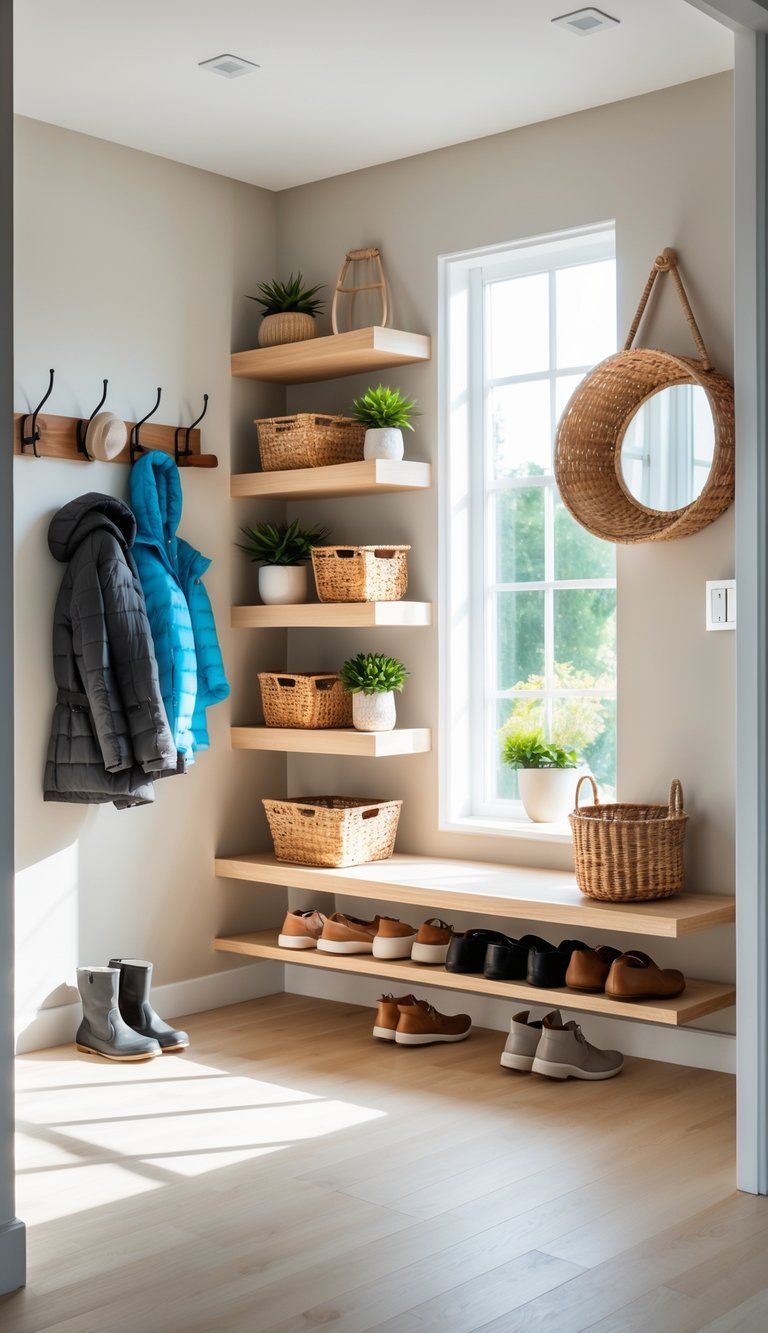
Using your walls is the secret to a functional entryway. Wall storage keeps the floor clear and your everyday stuff within reach.
Wall Hooks and Coat Racks
Wall hooks turn blank walls into storage. Put some up high for adults, some lower for kids. Decorative hooks look good even when empty.
Coat racks come in all shapes—standing, wall-mounted, you name it. If you’re short on space, a slim wall rack with a shelf above works wonders.
Heavy coats need sturdy hooks—go for metal, rated for at least 25 pounds. Keep hooks close to the door, but not right in the way.
Tip: Group things on hooks—bags on one, coats on another, kids’ stuff lower down.
Floating and Wall-Mounted Shelves
Floating shelves add storage without crowding the floor. Put one up high for stuff you don’t grab every day—like extra hats or holiday decor.
For daily things, use a narrow shelf with dividers at eye level. It’s the perfect drop zone for mail, keys, or sunglasses. Add baskets to keep little stuff from spreading everywhere.
Shelves with hooks underneath are a two-in-one win. Store baskets or decor up top, hang bags and coats below.
Try a small floating shelf by the door with a dish for keys and maybe a charging spot for your phone. That way, you always know where your essentials are.
Cubbies and Shoe Storage Options
If you want to keep your entryway tidy, shoe storage really matters. Wall-mounted cubbies lift shoes off the floor and make them easy to grab. Try labeling the cubbies for each family member—maybe that’ll help keep things organized.
A slim shoe cabinet with tilting drawers hides your footwear and barely takes up space. Most of these cabinets are just 6-8 inches deep, so they fit well in narrow entryways.
Families with a mountain of shoes might like a bench with storage underneath. You get a spot to sit while putting on shoes, plus hidden storage. Benches with divided compartments make it easier to sort everyone’s pairs.
Open cubbies are great for shoes you wear all the time. Closed storage keeps seasonal shoes out of sight. Keep lower cubbies for kids so they can reach their own shoes—makes mornings a bit less hectic.
Space-saving idea: If your floor space is almost nonexistent, hang a vertical shoe rack on the back of the door. It works surprisingly well.
Creative Storage Accessories
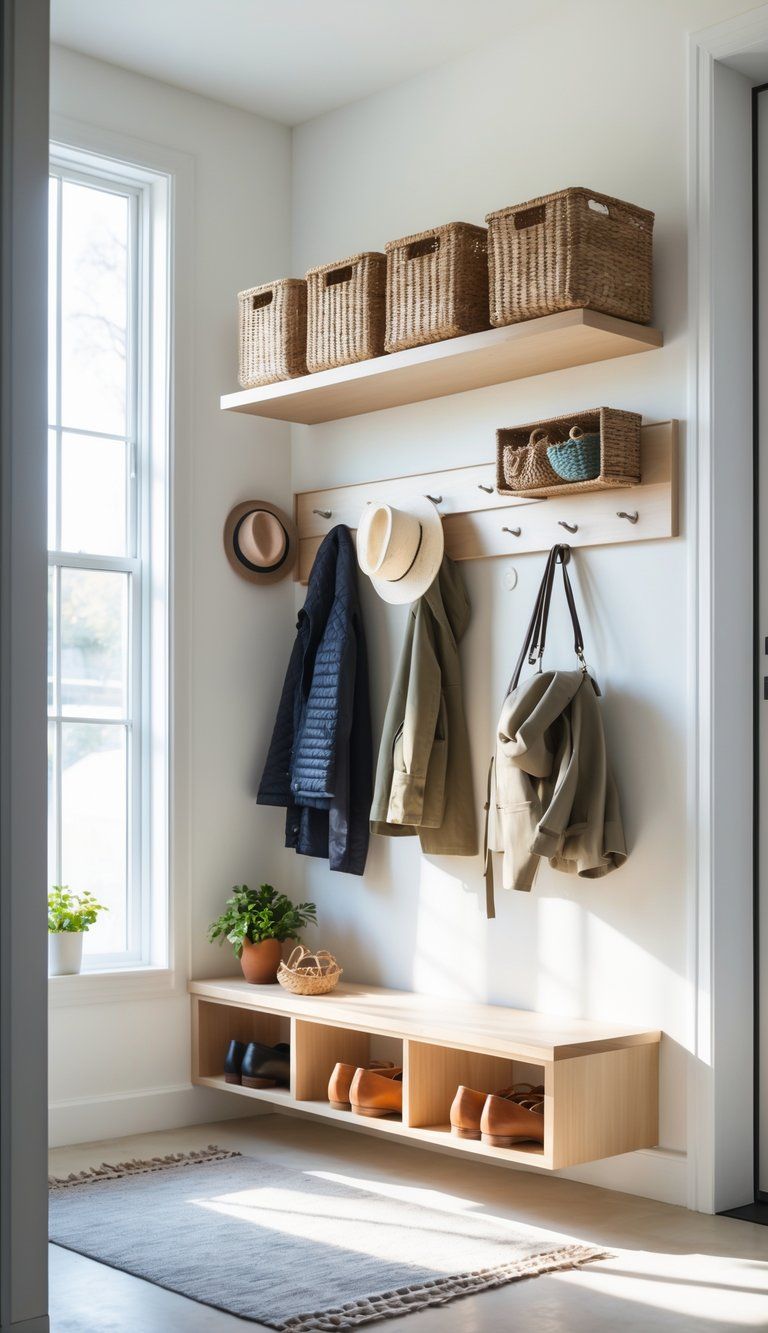
Smart storage accessories can totally change a cramped entryway. The right mix of containers and built-ins keeps your daily stuff organized and adds a little style.
Stylish Baskets and Containers
Woven baskets add a cozy texture and warmth, plus they’re practical. Stick a few baskets under a bench or on shelves to catch gloves, scarves, or the dog’s leash.
If you want to hide clutter, baskets with lids do the trick. Clear plastic bins help families with kids—everyone can see what’s inside. Labeling each container helps keep things in order, at least in theory.
Decorative trays on console tables give you a home for keys, mail, or sunglasses. Metal trays look modern, while wood brings a rustic vibe.
Stackable fabric bins in matching colors make good use of vertical space and keep everything looking pulled together.
Floating Cabinets and Built-ins
Floating cabinets free up precious floor space and fit nicely in slim entryways. Install one at counter height for a spot to drop keys and mail, with closed storage underneath for shoes or out-of-season gear.
Built-in cabinets let you customize every inch, even in tight corners. A shallow cabinet can hold a surprising amount and still look neat.
For a modern look, try floating shelves with hooks underneath. You get display space for cute items and practical storage for coats and bags.
If you really want to hide clutter, go for furniture-style cabinets with doors. Adjustable shelves inside help you adapt as your storage needs change.
Design Elements for a Welcoming Atmosphere
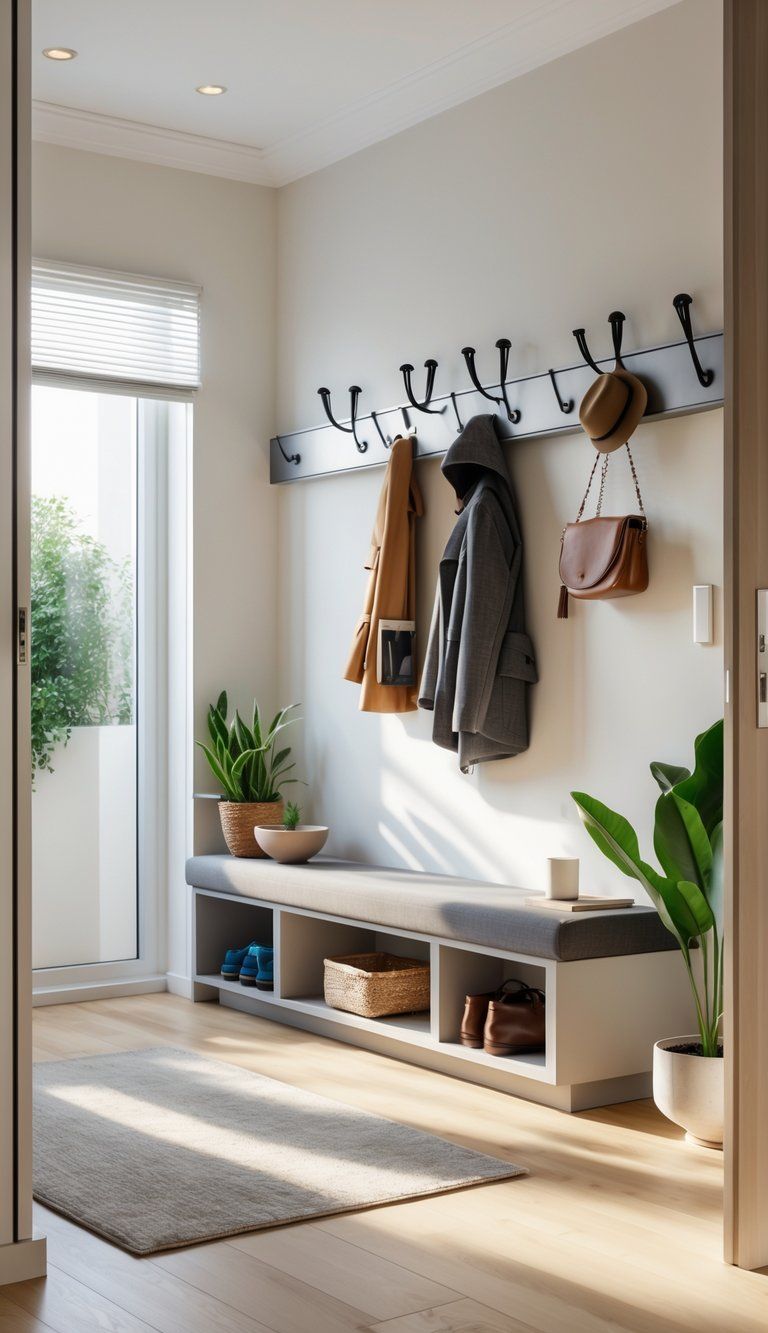
A warm, inviting entrance starts with thoughtful design choices. The right mix of textures, colors, and useful pieces can make even a tiny entryway feel welcoming.
Selecting Entryway Rugs
An area rug does more than just protect your floors—it defines the space and adds some instant coziness. Pick durable materials like wool or polypropylene, since they handle heavy traffic and are easy to clean.
If your entryway is small, try a runner that guides people in. Bigger spaces can handle a 4′ x 6′ or even a 5′ x 8′ rug to carve out a welcoming zone.
A few rug features to think about:
- Indoor/outdoor materials that clean up fast
- Dark patterns to hide dirt
- Non-slip backing for safety
- Seasonal options you can swap out
Choose a rug that matches your color scheme but can still take a beating from boots and umbrellas.
Incorporating Mirrors for Light and Space
Mirrors in the entryway do more than one job. They bounce natural light around, making small spaces brighter and bigger. You also get a quick place to check your look before heading out.
If you can, hang your mirror across from a window to catch more light. An oversized mirror makes a bold statement and still works hard.
Pick a mirror style that fits your home:
- Modern: Frameless or simple metal frames
- Traditional: Ornate gold or wood frames
- Transitional: Subtle details like beveled edges
Mount the mirror at eye level—about 57 to 65 inches from the floor. If you have kids, a full-length mirror might be worth it so everyone can use it.
Choosing Wallpaper and Paint
Your entryway walls give guests their first color impression. Bold wallpaper can make a small space memorable, while the right paint color connects the entry to the rest of your home.
Wallpaper brings texture and pattern you just can’t get with paint. Try vertical stripes to make ceilings seem higher, or small patterns for tight spaces. Washable wallpaper is a must in high-traffic spots.
For paint, semi-gloss or satin finishes are tough and easy to clean. Lighter shades open up small entryways, while deeper colors add a cozy, sophisticated vibe.
Don’t ignore the ceiling! A painted ceiling or subtle wallpaper overhead adds a fun surprise when people look up.
Optimizing Lighting and Illumination
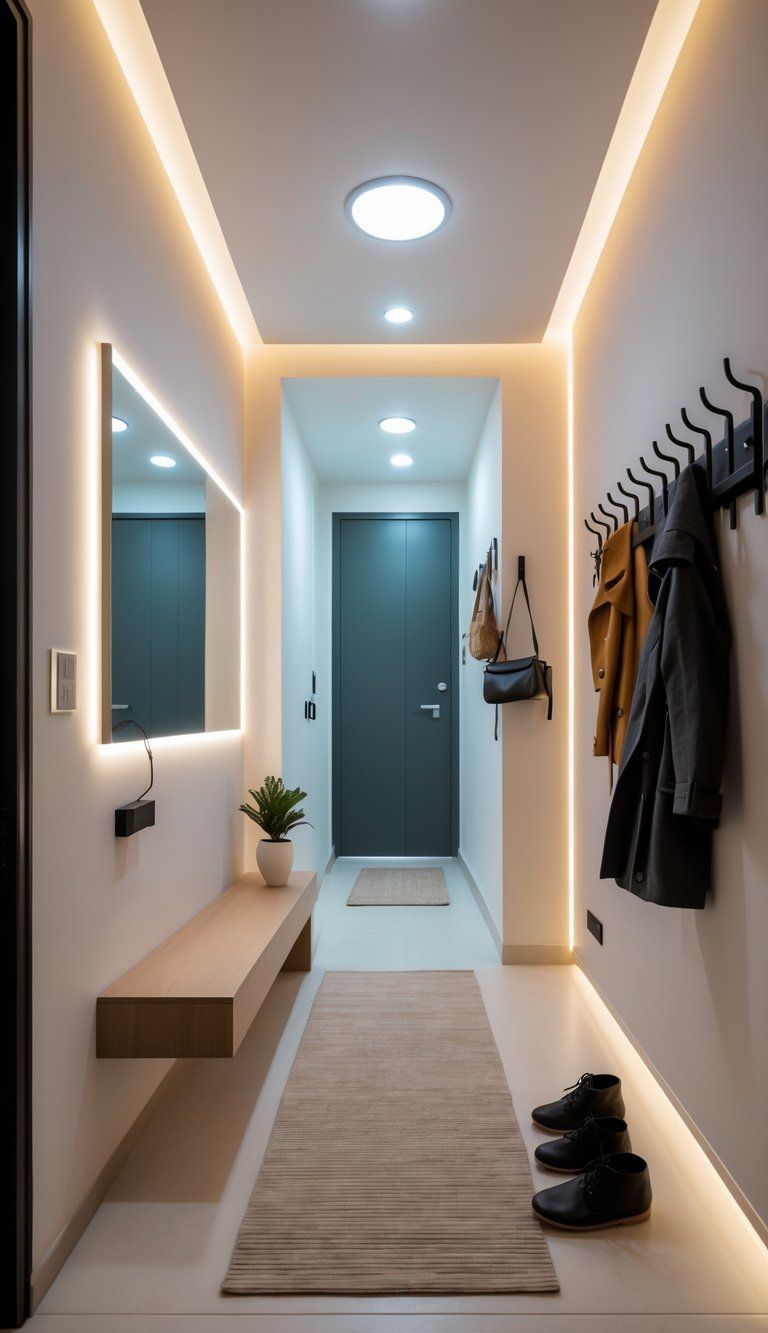
Good lighting turns an entryway into a true welcome zone. The right illumination helps you find your keys and sets the mood for the whole house.
Entryway Light Fixtures
Choosing the right fixtures really makes a difference. In small spaces, flush-mount or semi-flush ceiling lights give you plenty of light without crowding things visually.
If your entry has higher ceilings, pendant lights add style and direct light where you need it. Pick one that matches your home’s vibe.
For a bit of drama, a statement chandelier can double as lighting and a showpiece.
Wall sconces work well in narrow hallways or as extra lighting. Mount them at eye level—around 5.5 to 6 feet up.
Layered Lighting Approaches
Mixing different types of lighting adds depth and makes the space more useful. Start with ambient lighting—your main overhead fixture.
Add task lighting where you need it, like a table lamp on a console for sorting mail or finding your bag.
Accent lighting highlights cool features or art. Small recessed lights or picture lights can draw the eye to something special.
If you have room, a floor lamp brings in extra light and some style—no electrician required.
Smart lighting systems let you tweak brightness and color temperature. Set different moods for morning, evening, or when guests drop by.
Utilizing Natural Light
Make the most of any natural light your entryway gets. If you have windows or a glass door, keep window treatments simple or use sheer curtains to let light in.
A well-placed mirror across from a window bounces daylight deeper into the room. This trick can make a small entryway feel a whole lot bigger.
Light-colored walls and glossy finishes help reflect even more natural light. Semi-gloss paint works well for this.
If privacy is an issue, try frosted film on glass doors. You’ll get light without giving up privacy, and decorative films come in all sorts of patterns.
For dark entryways, daylight-mimicking LED bulbs (around 5000K) can fake the look of sunshine.
Personal Touches and Seasonal Updates
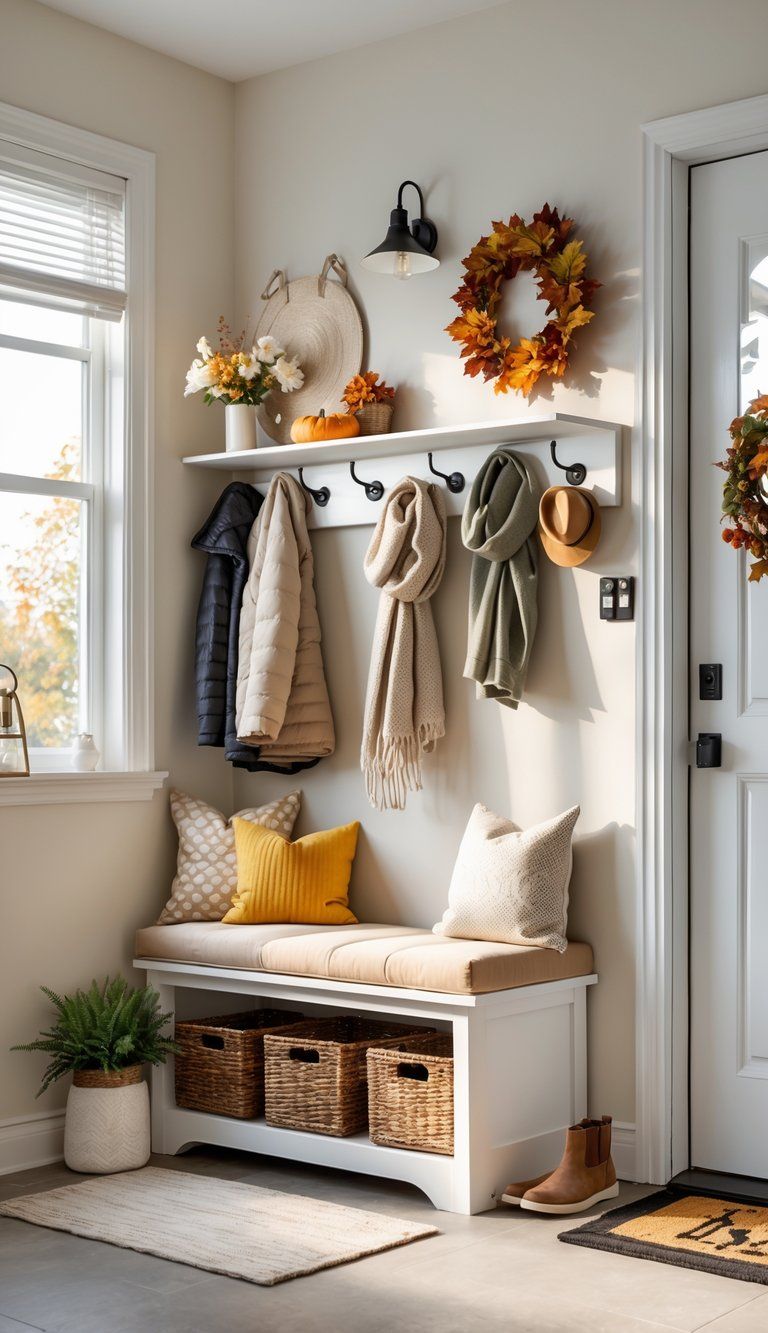
Your entryway should show off your personality and change with the seasons. A few personal touches make this space feel like yours, not just a spot to drop shoes.
Displaying Artwork and Photographs
Artwork and photos instantly warm up an entryway. Pick pieces that make you happy or spark conversation. A single statement piece works in a small space, but you can hang several if you have more room.
Try:
- Family photos in matching frames
- Travel souvenirs that tell your story
- Kids’ art in simple frames
- Local art to support your community
Hang art at eye level—about 57-60 inches from the floor. In small spaces, swap out pieces seasonally to keep things interesting without piling up clutter.
Decorating with Greenery and Plants
Plants breathe life into your entryway and clean the air. Choose types that match your light and your willingness to water them.
Bright entryways:
- Fiddle leaf fig
- Rubber plant
- Snake plant
Low-light entryways:
- ZZ plant
- Pothos
- Spider plant
If space is tight, try wall planters or tiny succulents on a shelf. Bigger entryways can handle a statement floor plant in a cool pot.
Faux plants are a solid choice if you travel a lot or your entry gets no sun. Some fake plants look so real, it’s hard to tell the difference.
Adding a Gallery Wall
A gallery wall turns your entryway into a mini museum. Mix frames, sizes, and art types for interest, but stick to a color or theme so it doesn’t get chaotic.
Here’s how to start:
- Gather your items—frames, mirrors, small shelves, or wall art
- Lay them out on the floor first to play with arrangements
- Tape up paper templates before you start hammering
- Begin with the center piece and work out from there
Leave some space between items—2-3 inches works well. In a narrow hallway, try a line that follows the path. You might add a small shelf to display objects or change out seasonal decor.
Updating with Seasonal Decor
Seasonal touches keep your entryway fresh without a big overhaul. Swap out a few things, don’t redo everything.
Spring/Summer:
- Bright pillows on benches
- Light curtains
- Fresh flowers
- Beachy accents
Fall/Winter:
- Cozy textiles like wool or velvet
- Warm lighting—maybe candles or string lights
- Seasonal wreaths inside
- Scented diffusers for a homey feel
A “Today’s Memory” chalkboard or letter board adds personality and is easy to update. Try a doormat you can change with the seasons—florals for spring, cozy for fall, and something festive for winter.
Materials and Durability in Entryway Design
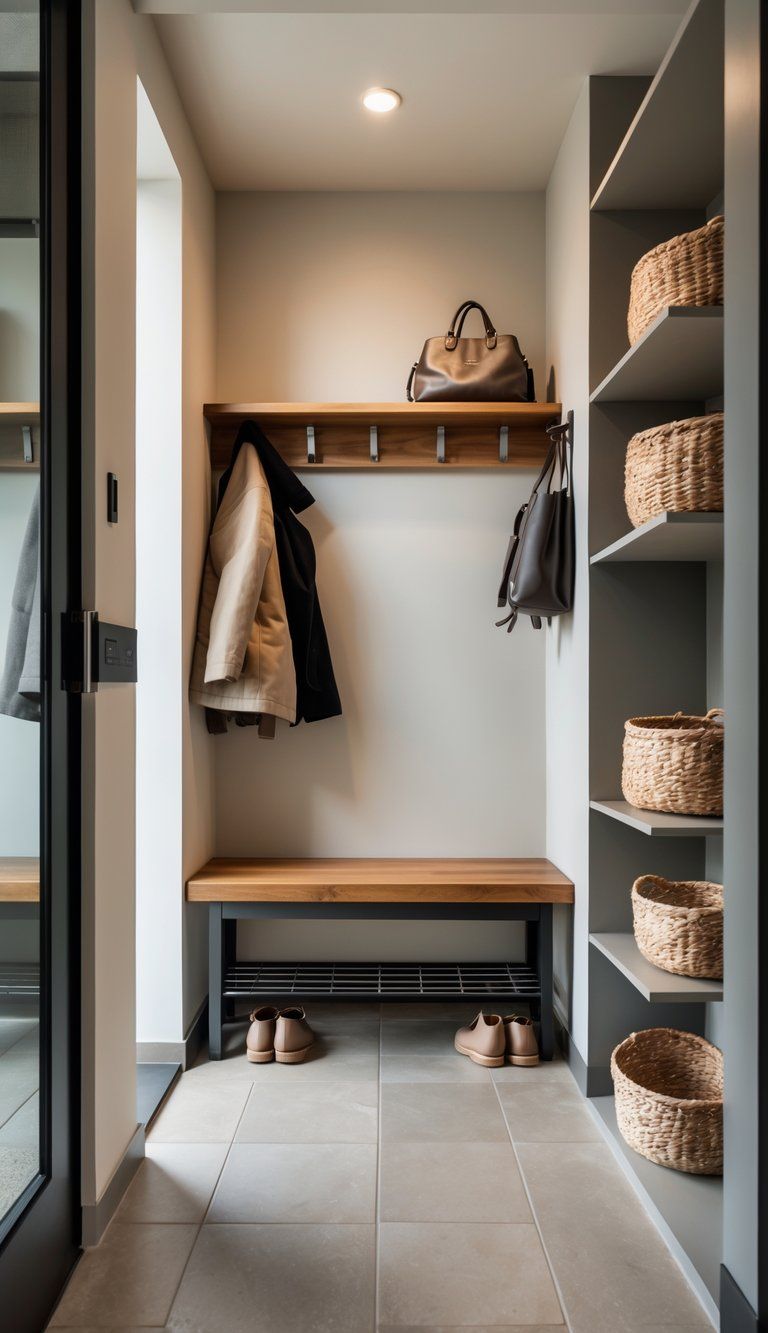
Entryways see a lot of action and weather, so materials really matter. Pick stuff that lasts and still looks good after years of use.
Choosing Durable Flooring and Tiles
Entryway floors need to handle water, dirt, and heavy traffic. Porcelain tile works well—it’s tough and shrugs off moisture, which is great if you get a lot of rain or snow. You can find tiles that look like stone or wood but perform better.
Natural stone like slate or limestone brings classic style, but you’ll need to seal it to prevent stains. Engineered hardwood gives you warmth and resists warping better than solid wood.
Luxury vinyl tile (LVT) offers a budget-friendly, waterproof, and scratch-resistant option. Many modern LVTs look just like wood or stone for a lot less money.
Add a tough rug or mat at the door to catch dirt before it spreads. Go for washable, quick-drying materials like indoor/outdoor polypropylene.
Selecting Functional and Stylish Materials
When picking entryway furniture or storage, look for materials that blend good looks and practicality. Solid wood benches with a protective finish resist scratches and give you a spot to sit. If you live somewhere humid, water-resistant finishes help.
Metal hooks and rails bring an industrial vibe and handle daily use. Think about:
- Brass or bronze hardware that ages nicely
- Powder-coated steel for a modern, chip-resistant option
- Brushed nickel, which hides fingerprints and water spots
Natural materials like bamboo, rattan, or seagrass baskets add warmth and texture. They’re eco-friendly and surprisingly sturdy.
For walls, washable paint in a satin or semi-gloss finish lets you wipe away scuffs. Vinyl wallpaper stands up better to moisture than paper types.
Ideas for Narrow Entryways and Unique Layouts
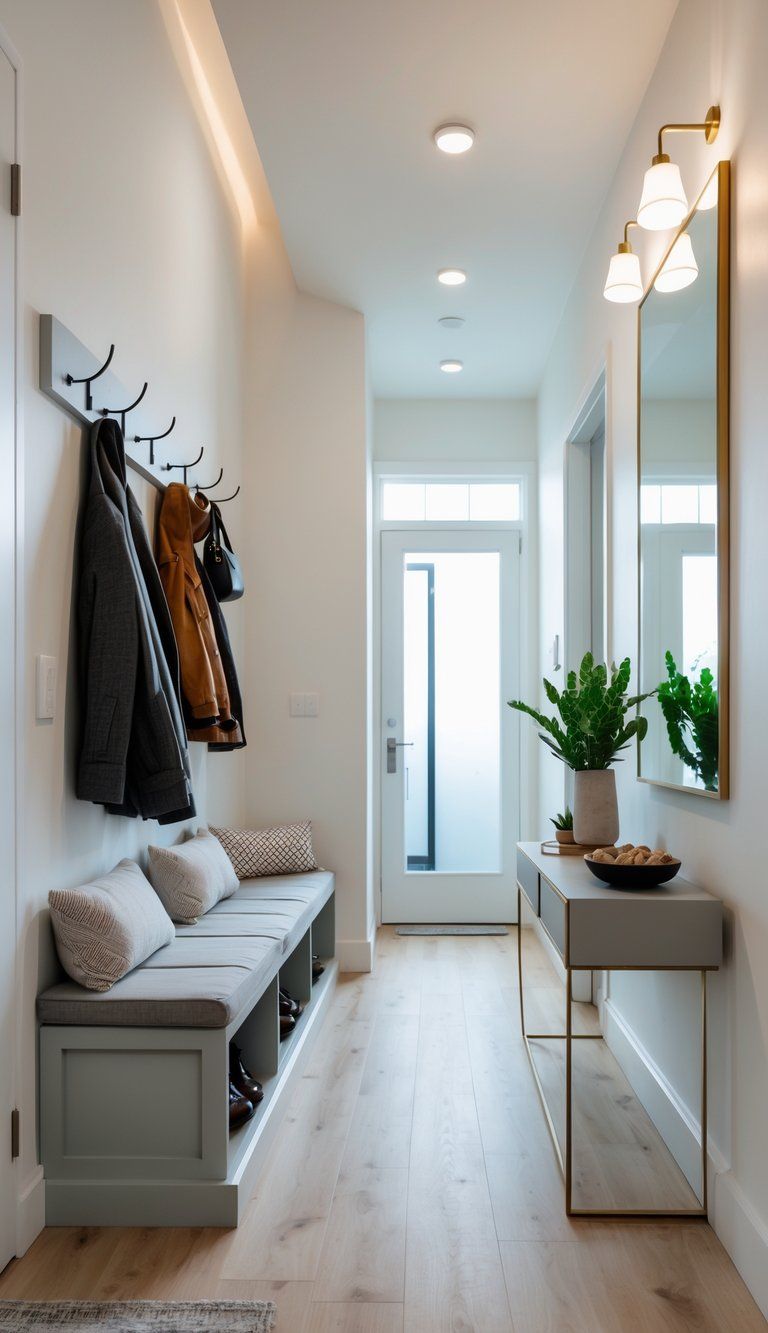
Narrow entryways can actually turn into functional, stylish spaces if you use the right design tricks. Most people ignore these spots, but honestly, they’ve got tons of potential to make your home feel more inviting and practical at the same time.
Implementing Room Dividers
You can use room dividers to carve out an entryway where there isn’t one yet. Try putting a bookshelf perpendicular to the wall; it defines a little entry space and gives you some handy storage, too.
Go for open shelving if you want to keep things light and airy.
Folding screens work well when you need a divider that doesn’t have to stay put. Move or fold them away if you’re hosting a crowd.
Some screens even come with built-in hooks, which is just smart.
Curtains can also act as gentle dividers. If you install ceiling-mounted tracks, you can pull the fabric closed for privacy or open it up for a breezy vibe.
Tall plant stands or a line of potted greenery make surprisingly good natural dividers. They break up the space and add a little life to your entrance, which never hurts.
Strategies for Small Spaces
Try wall-mounted solutions to save that precious floor space. You can put up hooks, small shelves, or even floating cabinets at different heights—suddenly, you’ve got a functional drop zone and you didn’t even need a bulky console table.
Don’t forget to look up and use your vertical space. Tall, skinny cabinets or shelving units with a tiny footprint give you lots of storage without hogging the floor.
If you’re dealing with tight quarters, you really can’t skip multi-functional furniture. Grab a bench with hidden storage; you’ll have a spot to sit while you pull off your shoes, plus somewhere to stash seasonal stuff.
Mirrors work wonders—they make the space look bigger and actually do something useful too. Try putting a mirror across from a window so it can bounce the light around and make your narrow entryway feel almost twice as wide.
Stick to light colors on the walls if you want the area to seem larger. Soft whites, pale grays, or maybe a light blue can help a cramped space feel a lot more open and friendly.

